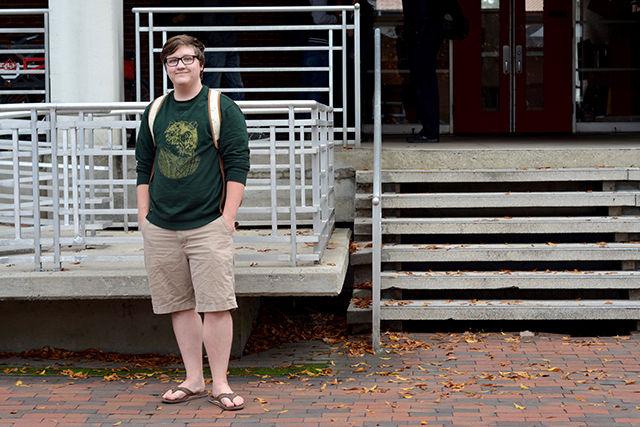 " />
" />
Sam Feldstein
Junior in civil engineering Ian Pike stands in front of the main building for his major, Mann Hall. "As a transgender student, I'm trying to diversify what it means to be in STEM," Pike said.
Two acronyms rarely seen paired together are GLBT and STEM.
According to Ian Pike, a sophomore studying civil engineering, GLBT students are a big part of the science, technology, engineering and math fields, but they’re not very visible.
He said that despite growing acceptance in American society, there is still a considerable amount of anxiety surrounding coming out in STEM majors. Pike and Kyle Vey, a senior studying biomedical engineering, hope to combat this fear by starting a chapter of the national group oSTEM (Out in STEM) to NC State’s campus next semester.
“It’s not that [GLBT students] are not there, it’s just that they are not represented; they don’t feel safe being there as authentically as they want to be, so it’s definitely just like a culture of fear,” Pike said.
Pike started in computer science but said the major wasn’t going well for him and “neither was his gender,” so he dropped out of school to figure it out.
“I’m transgendered and bisexual, so I get half the letters,” Pike joked.
He ended up choosing civil engineering because he was helping people, but from “backstage.” He currently works for the Department of Transportation in the traffic safety unit as an intern.
But according to Pike and countless national reports, the job search for GLBT students can be scary because gender identity and sexual orientation are not legally protected classes federally or in most states.
“If I work for the state government, I could be fired for being trans, so I don’t want to be out at work,” Pike said. “That would be scary if I came out and my boss thought it was a negative thing.”
Because Pike appears to be a straight man to someone who doesn’t know his identity, the conversation doesn’t have to come up; however, he wishes it could because it’s not something he hides anywhere else.
According to Renee Wells, the director of the GLBT Center, the reason GLBT students aren’t visible in the STEM field is because the dialogue isn’t either.
She said the coursework does not spark conversations about sexuality and identity like it would in the humanities, so students do not feel comfortable talking about their own sexuality and identity. Wells said STEM professors should be more intentional about signaling they are inclusive of all their students.
She noted a significant skew toward humanities fields in the GLBT-CA’s Project Safe Ally training, a course that teaches faculty and staff how to be inclusive and supportive to students with all genders and sexualities and gives them a sticker to place on their door to show solidarity.
“I think statistically if you look at the faculty and staff who go through our Project Safe Ally training, they tend to be heavily from liberal arts and humanities fields,” Wells said. “So I think that kind of perpetuates the idea that maybe this isn’t a safe space, not that STEM fields in any way are overtly hostile but I think it’s just this compounding of we are not having these conversations and people aren’t putting stickers out that say ‘hey you’re queer, you’re here, come on in,’” Wells said.
That’s part of why Pike and Vey want to create a safe space for the GLBT community to network in the STEM fields and discuss and overcome some of the challenges they could face professionally.
“We are a STEM school, we are heavily engineering and science-focused and we are also heavily focused on diversity,” Pike said. “It didn’t make sense that it wasn’t already here.”
He went on to explain that when he attended STEM professional development groups, they were great, but he left with many important questions unanswered, like how he should to talk to a recruiter and ask about the discrimination policy or how to find the best GLBT-friendly companies in his field.
According to Eric Patridge, founder and president of the national oSTEM professional society, the group strives to help connect people with their peers who are at their same level and who can help advance them in their career.
“OSTEM helps to revive the peer-to-peer network that will help LGBTQA students succeed in STEM fields,” Patridge said.
According to Pike, STEM is a broad category that has diverse career paths that can lead to highly accepting groups of professionals on one end and old-school boys clubs on the other.
Because of that variety, some students, like Jason Endries, a senior studying meteorology, don’t feel like being a member of the GLBT factors into their STEM experience, in school our out.
“I want to get into wind power meteorology, which if you are in the wind industry I can see the people being more progressive and forward thinking,” Endries said.
Either way, Pike says oSTEM will hold planning meetings next semester and will welcome anyone who wants to support launching their science career as a young, out professional. To get involved, contact Pike at itpike@ncsu.edu.